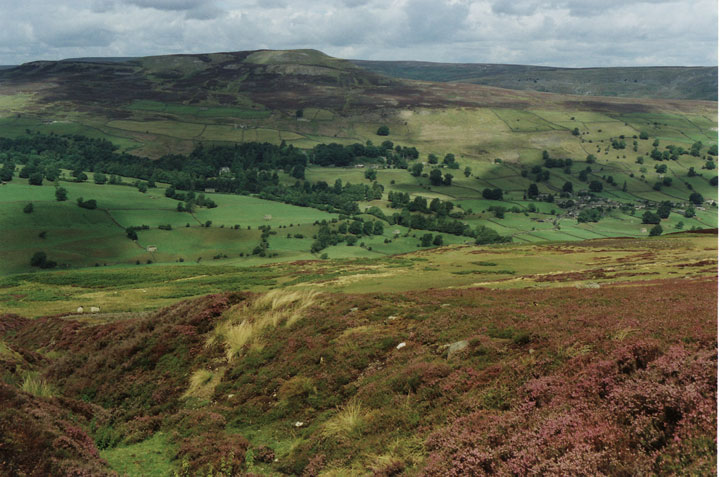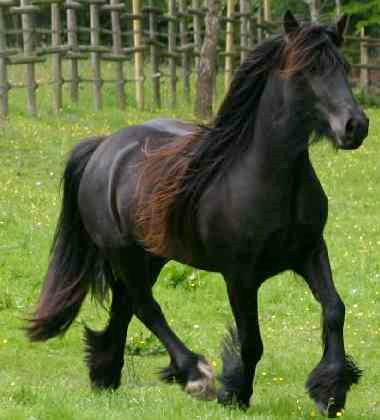|
Galloway Pony
The Galloway pony is an extinct horse breed, once native to Scotland and northern England. It was said to have "good looks, a wide, deep chest and a tendency to pace rather than trot." In the 18th century Galloways were bred in Swaledale, to haul lead ore. The breed was mentioned by Shakespeare as "Galloway nags" in Henry IV, Part 2. "Thrust him down stairs! know we not Galloway nags?" Pistol - Henry IV, Part 2 by William Shakespeare A survey in 1814 stated: The province of Galloway formerly possessed a breed of horses peculiar to itself, which were in high estimation for the saddle, being, though of a small size, exceedingly hardy and active. They were larger than the ponies of Wales, and the north of Scotland, and rose from twelve to fourteen hands in height. The soils of Galloway, in their unimproved state, are evidently adapted for rearing such a breed of horses; and in the moors and mountainous part of the country, a few of the native breed are still to be found. … Th ... [...More Info...] [...Related Items...] OR: [Wikipedia] [Google] [Baidu] |
Galloway
Galloway ( ; sco, Gallowa; la, Gallovidia) is a region in southwestern Scotland comprising the historic counties of Wigtownshire and Kirkcudbrightshire. It is administered as part of the council area of Dumfries and Galloway. A native or inhabitant of Galloway is called a Gallovidian. The place name Galloway is derived from the Gaelic ' ("amongst the '"). The , literally meaning "Stranger-'"; the specific identity of whom the term was applied to is unknown, but the predominant view is that it referred to an ethnic and/or cultural identity such as the Strathclyde Britons or another related but distinct population. A popular theory is that it refers to a population of mixed Scandinavian and Gaelic ethnicity that may have inhabited Galloway in the Middle Ages. Galloway is bounded by sea to the west and south, the Galloway Hills to the north, and the River Nith to the east; the border between Kirkcudbrightshire and Wigtownshire is marked by the River Cree. The definition has ... [...More Info...] [...Related Items...] OR: [Wikipedia] [Google] [Baidu] |
Horse Breed
A horse breed is a selectively bred population of domesticated horses, often with pedigrees recorded in a breed registry. However, the term is sometimes used in a broader sense to define landrace animals of a common phenotype located within a limited geographic region, or even feral "breeds" that are naturally selected. Depending on definition, hundreds of "breeds" exist today, developed for many different uses. Horse breeds are loosely divided into three categories based on general temperament: spirited "hot bloods" with speed and endurance; "cold bloods," such as draft horses and some ponies, suitable for slow, heavy work; and "warmbloods," developed from crosses between hot bloods and cold bloods, often focusing on creating breeds for specific riding purposes, particularly in Europe. Horse breeds are groups of horses with distinctive characteristics that are transmitted consistently to their offspring, such as conformation, color, performance ability, or disposition. These ... [...More Info...] [...Related Items...] OR: [Wikipedia] [Google] [Baidu] |
Scotland
Scotland (, ) is a country that is part of the United Kingdom. Covering the northern third of the island of Great Britain, mainland Scotland has a border with England to the southeast and is otherwise surrounded by the Atlantic Ocean to the north and west, the North Sea to the northeast and east, and the Irish Sea to the south. It also contains more than 790 islands, principally in the archipelagos of the Hebrides and the Northern Isles. Most of the population, including the capital Edinburgh, is concentrated in the Central Belt—the plain between the Scottish Highlands and the Southern Uplands—in the Scottish Lowlands. Scotland is divided into 32 administrative subdivisions or local authorities, known as council areas. Glasgow City is the largest council area in terms of population, with Highland being the largest in terms of area. Limited self-governing power, covering matters such as education, social services and roads and transportation, is devolved from the Scott ... [...More Info...] [...Related Items...] OR: [Wikipedia] [Google] [Baidu] |
England
England is a country that is part of the United Kingdom. It shares land borders with Wales to its west and Scotland to its north. The Irish Sea lies northwest and the Celtic Sea to the southwest. It is separated from continental Europe by the North Sea to the east and the English Channel to the south. The country covers five-eighths of the island of Great Britain, which lies in the North Atlantic, and includes over 100 smaller islands, such as the Isles of Scilly and the Isle of Wight. The area now called England was first inhabited by modern humans during the Upper Paleolithic period, but takes its name from the Angles, a Germanic tribe deriving its name from the Anglia peninsula, who settled during the 5th and 6th centuries. England became a unified state in the 10th century and has had a significant cultural and legal impact on the wider world since the Age of Discovery, which began during the 15th century. The English language, the Anglican Church, and Engli ... [...More Info...] [...Related Items...] OR: [Wikipedia] [Google] [Baidu] |
Swaledale
Swaledale is one of the northernmost dales (valleys) in Yorkshire Dales National Park, located in northern England. It is the dale of the River Swale on the east side of the Pennines in North Yorkshire. Geographical overview Swaledale runs broadly from west to east, from the high moors on the Cumbria–Yorkshire boundary at the watershed of Northern England to the market town of Richmond, where the dale meets the lowlands. Nine Standards Rigg, the prominent ridge with nine ancient tall cairns, rises on the watershed at the head of Swaledale. To the south and east of the ridge a number of smaller dales (Birkdale, Little Sleddale, Great Sleddale and Whitsundale) join to form the narrow valley of upper Swaledale at the small village of Keld. From there, the valley runs briefly south then turns east at Thwaite to broaden progressively as it passes Muker, Gunnerside, Low Row, Healaugh and Reeth. The Pennine valley ends at Richmond, where an important medieval castle sti ... [...More Info...] [...Related Items...] OR: [Wikipedia] [Google] [Baidu] |
Shakespeare
William Shakespeare ( 26 April 1564 – 23 April 1616) was an English playwright, poet and actor. He is widely regarded as the greatest writer in the English language and the world's pre-eminent dramatist. He is often called England's national poet and the " Bard of Avon" (or simply "the Bard"). His extant works, including collaborations, consist of some 39 plays, 154 sonnets, three long narrative poems, and a few other verses, some of uncertain authorship. His plays have been translated into every major living language and are performed more often than those of any other playwright. He remains arguably the most influential writer in the English language, and his works continue to be studied and reinterpreted. Shakespeare was born and raised in Stratford-upon-Avon, Warwickshire. At the age of 18, he married Anne Hathaway, with whom he had three children: Susanna Hall, Susanna, and twins Hamnet Shakespeare, Hamnet and Judith Quiney, Judith. Sometime between 1585 and 1592, ... [...More Info...] [...Related Items...] OR: [Wikipedia] [Google] [Baidu] |
Newfoundland Pony
The Newfoundland pony is a horse breed, breed of pony originating in Newfoundland (island), Newfoundland, Canada. They are sturdy and muscular ponies, found in many equine coat color, colors, including the relatively rare white (horse), white coloration. The Newfoundland developed from a mix of English, Irish and Scottish pony breeds brought to Newfoundland by settlers over a period of four centuries. Initially free-roaming, they crossbred to produce the modern type. They were used by settlers as draft horse, draft and multi-purpose ponies until the mid-20th century, when they were brought almost to the point of extinction by mechanization and horse slaughter, slaughter. The population rebounded slightly after the formation of a breed registry in 1980, but still remains low. In 1997, the Newfoundland pony was declared a heritage breed of Newfoundland and Labrador, which afforded it protection under the law, but the breed has not yet been recognized under the Canadian federal ... [...More Info...] [...Related Items...] OR: [Wikipedia] [Google] [Baidu] |
Fell Pony
The Fell pony is a versatile working breed of mountain and moorland pony originating on Cumberland and Westmorland farms of northwest England and is used for riding and driving. The breed is closely related to its geographic neighbour, the Dales Pony, but is a little smaller and more pony-like in build. The Fell Pony is noted for hardiness, agility, strength and sure-footedness. Breed characteristics Fell Ponies vary a good deal in weight and size, so ponies may be found to carry almost any rider. The average height of the breed is , and the upper height limit for the breed is . The breed was bred for the unforgiving mountainous environment of Cumbria in north-west England, so they are adaptable to almost any temperate climate. The colours accepted in the breed are black, dark chestnut, bay, grey, and chestnuts (if both parents are registered). Piebalds, and skewbalds are not allowed. A star on the head and/or a small amount of white on or below the hind fetlock is acc ... [...More Info...] [...Related Items...] OR: [Wikipedia] [Google] [Baidu] |
Crossbreeding
A crossbreed is an organism with purebred parents of two different breeds, varieties, or populations. ''Crossbreeding'', sometimes called "designer crossbreeding", is the process of breeding such an organism, While crossbreeding is used to maintain health and viability of organisms, irresponsible crossbreeding can also produce organisms of inferior quality or dilute a purebred gene pool to the point of extinction of a given breed of organism. A domestic animal of unknown ancestry, where the breed status of only one parent or grandparent is known, may also be called a crossbreed though the term "mixed breed" is technically more accurate. Outcrossing is a type of crossbreeding used within a purebred breed to increase the genetic diversity within the breed, particularly when there is a need to avoid inbreeding. In animal breeding, ''crossbreeds'' are crosses within a single species, while '' hybrids'' are crosses between different species. In plant breeding terminology, the term ' ... [...More Info...] [...Related Items...] OR: [Wikipedia] [Google] [Baidu] |
Narragansett Pacer
The Narragansett Pacer was the first horse breed developed in the United States, but is now extinct. It was developed in the United States during the 18th century and associated closely with the state of Rhode Island, and it had become extinct by the late 19th century. The Pacer was developed from a mix of English and Spanish breeds, although the exact cross is unknown, and they were known to and owned by many famous personages of the day, including George Washington. Sales to the Caribbean and cross-breeding diminished the breed to the point of extinction, and the last known Pacer died around 1880. The Narragansett was possibly an ambling horse, rather than a true pacing breed. It was known as a sure-footed, dependable breed, although not flashy or always good-looking. Pacers were used for racing and general riding. They were frequently crossed with other breeds, and provided the foundation for several other American breeds, including the American Saddlebred, Standardbred and T ... [...More Info...] [...Related Items...] OR: [Wikipedia] [Google] [Baidu] |







